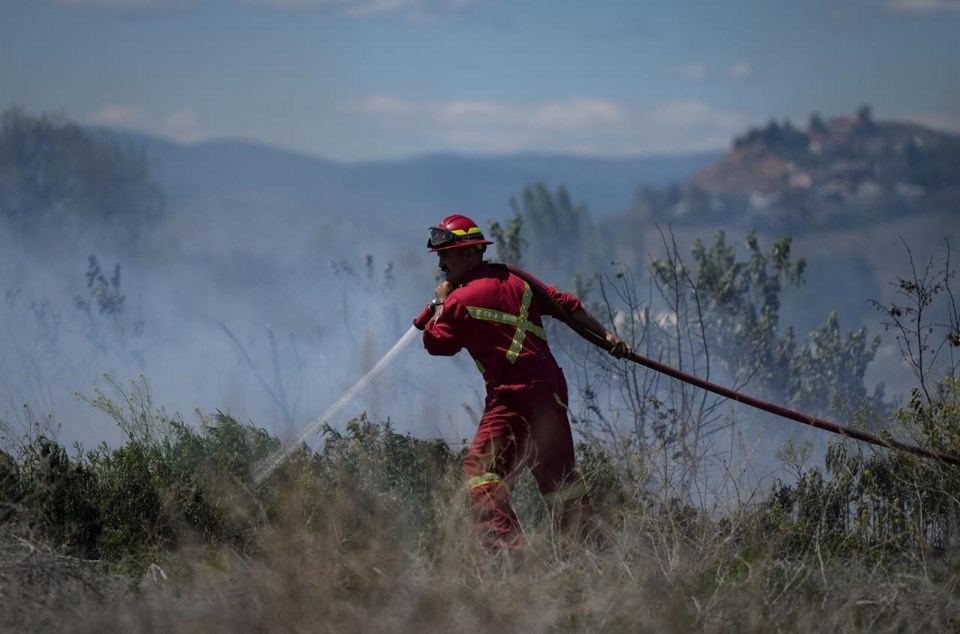MONTREAL — The techniques used to put out the wildfires that are burning across Canada vary somewhat depending on geography, but ultimately they depend on people on the ground with hoses and shovels digging out hot spots one by one, experts say.
As of midday Thursday, there were 430 fires burning across Canada, including 235 that were out of control, according to the Canadian Interagency Forest Fire Centre.
Regardless of how many fires there are, the tactics to put them out remain largely the same, involving a combination of air attacks and firefighters working on the ground, said a longtime firefighter and former member of the Ontario Ministry of Natural Resources' fire program.
Dave Cowan, who now trains new recruits with the private company Fire 1, said that while aircraft can help stop a fire's advance, the hard work of putting it out is always done at ground level.
"The water bombers are a great support system, but they’re not going to put the fire out," he said in an interview this week. "It’s that person with the shovel at the end of the day that is going to put that last hot spot out."
Cowan said firefighting tactics depend partly on the landscape. In Ontario and Quebec, where lakes are plentiful, the bulk of the work is done with water, either mixed with foam and dropped from aircraft, or pumped from lakes and rivers into hoses that are manned by firefighters on the ground.
In drier places, such as British Columbia, there's a greater use of fire retardant — which is placed around the fire's edge — and preventive burning to strip an area of vegetation that acts as fuel, he said.
Stéphane Caron, a spokesman for Quebec's forest fire prevention agency, known as SOPFEU, said that while tactics in fighting fires are consistent, the sheer number of fires in his province is forcing the agency to abandon its goal of extinguishing all fires below the 51st parallel.
"There are far too many (fires) for us to do that, so at the moment our objective is really linked to the protection of communities, human lives and strategic infrastructure," he said in an interview this week. He said the agency's firefighting capacity is about 30 fires at a time. On Thursday, there were 133 fires in the province.
With resources in short supply, "our goal isn't necessarily to go until the fire is extinguished, but to contain and hopefully control it to be able to go take care of another fire."
Caron said the first line of attack against a fire is the water bomber aircraft, which can carry about 6,000 litres of water and must pass every 10 to 12 minutes to be effective.
However, he said the aircraft can only help contain a fire. It's the firefighters on the ground who extinguish a blaze, not only above ground with hoses but underground as well. That is done using a tool known as a Pulaski, similar to an axe, to dig into spots where the fire is hiding beneath the surface.
The biggest challenge in the current situation, he said, is that fires are happening simultaneously in several provinces at once, straining resources that are usually shared between provinces and forcing agencies to look abroad for reinforcements.
Roger Collet, wildfire management officer with the New Brunswick Department of Natural Resources, says fire efforts start by finding a spot that provides a good escape route, and then attacking the fire on its flanks before moving to the head.
He said that while tactics haven't changed substantially in recent years, they're being constantly refined by improvements in the technology that helps predict and monitor fires. Drones, for example, offer a cheaper and easier way to keep tabs on a fire than helicopters. "They're always tweaking the technology," he said.
The experts agree that when a fire is advancing, workers may have to fall back and focus on building defences to protect homes, businesses and critical infrastructure, such as communications towers. That can be done by using a bulldozer to raze a section of land and create a firebreak near the structures, or through a preventive burn of the vegetation.
Both Caron and Cowan say the main danger to firefighters is not being encircled by the fire, which is closely monitored, but rather injuries from falling trees, falls or heatstroke. The work is very demanding for firefighters, who have to contend with heat from the fires, mud and water, and difficult terrain.
"You're walking through the bush, which is logs laying there and hills and rocks," he said. "It's not like walking on a city block, I'll tell you, it's very demanding and it's hot."
He notes that a fire is not considered fully "out" until firefighters can walk all the way to the centre of a burned area and ensure there are no more hot spots that could reignite and start another fire.
This report by The Canadian Press was first published June 9, 2023.
Morgan Lowrie, The Canadian Press
